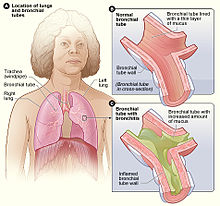| Acute bronchitis | |
|---|---|
| Other names | Chest cold |
 | |
| Figure A shows the location of the lungs and bronchial tubes. Figure B is an enlarged view of a normal bronchial tube. Figure C is an enlarged view of a bronchial tube with bronchitis. | |
| Specialty | Pulmonology |
| Symptoms | Cough with sputum, wheezing, shortness of breath, fever, chest discomfort[1][2] |
| Duration | Up to 6 weeks[3] |
| Causes | Typically viral infection[1] |
| Risk factors | Tobacco smoke, dust, air pollution[2] |
| Diagnostic method | Based on symptoms[4] |
| Differential diagnosis | Asthma, pneumonia, bronchiolitis, bronchiectasis, COPD[1] |
| Prevention | Avoiding air pollution, handwashing[5] |
| Treatment | Rest, paracetamol (acetaminophen), NSAIDs[3][6] |
| Frequency | ~5% one or more episodes a year[7][8] |
Acute bronchitis, also known as a chest cold, is short-term bronchitis – inflammation of the bronchi (large and medium-sized airways) of the lungs.[2][1] The most common symptom is a cough.[1] Other symptoms include coughing up mucus, wheezing, shortness of breath, fever, and chest discomfort.[2] The infection may last from a few to ten days.[2] The cough may persist for several weeks afterward with the total duration of symptoms usually around three weeks.[2][1] Some have symptoms for up to six weeks.[3]
In more than 90% of cases, the cause is a viral infection.[1] These viruses may be spread through the air when people cough or by direct contact.[2] Risk factors include exposure to tobacco smoke, dust, and other air pollution.[2] A small number of cases are due to high levels of air pollution or bacteria such as Mycoplasma pneumoniae or Bordetella pertussis.[1][9] Diagnosis is typically based on a person's signs and symptom.[4] The color of the sputum does not indicate if the infection is viral or bacterial.[1] Determining the underlying organism is typically not needed.[1] Other causes of similar symptoms include asthma, pneumonia, bronchiolitis, bronchiectasis, and COPD.[1][7] A chest X-ray may be useful to detect pneumonia.[1]
Prevention is by not smoking and avoiding other lung irritants.[5] Frequent hand washing and flu vaccination may also be protective.[5][10] Treatment of acute bronchitis typically involves rest, paracetamol (acetaminophen), and NSAIDs to help with the fever.[3][6] Cough medicine has little support for its use and is not recommended in children less than six years of age.[1][11] Antibiotics should generally not be used.[12] An exception is when acute bronchitis is due to pertussis.[1] Tentative evidence supports honey and pelargonium to help with symptoms.[1]
Acute bronchitis is one of the most common diseases.[3][13] About 5% of adults are affected and about 6% of children have at least one episode a year.[7][8] It occurs more often in the winter.[7] More than 10 million people in the United States visit a doctor each year for this condition with approximately 70% receiving antibiotics, most of which are not needed.[3] There are efforts to decrease the use of antibiotics in acute bronchitis.[13]
- ^ a b c d e f g h i j k l m n o Albert, RH (1 December 2010). "Diagnosis and treatment of acute bronchitis". American Family Physician. 82 (11): 1345–50. PMID 21121518.
- ^ a b c d e f g h "What Is Bronchitis?". August 4, 2011. Archived from the original on 2 April 2015. Retrieved 1 April 2015.
- ^ a b c d e f Tackett, KL; Atkins, A (December 2012). "Evidence-based acute bronchitis therapy". Journal of Pharmacy Practice. 25 (6): 586–90. doi:10.1177/0897190012460826. PMID 23076965. S2CID 37651935.
- ^ a b "How Is Bronchitis Diagnosed?". August 4, 2011. Archived from the original on 2 April 2015. Retrieved 1 April 2015.
- ^ a b c "How Can Bronchitis Be Prevented?". August 4, 2011. Archived from the original on 2 April 2015. Retrieved 1 April 2015.
- ^ a b "How Is Bronchitis Treated?". August 4, 2011. Archived from the original on 2 April 2015. Retrieved 1 April 2015.
- ^ a b c d Wenzel, RP; Fowler AA, 3rd (16 November 2006). "Clinical practice. Acute bronchitis". The New England Journal of Medicine. 355 (20): 2125–30. doi:10.1056/nejmcp061493. PMID 17108344.
{{cite journal}}: CS1 maint: numeric names: authors list (link) - ^ a b Fleming, DM; Elliot, AJ (March 2007). "The management of acute bronchitis in children". Expert Opinion on Pharmacotherapy. 8 (4): 415–26. doi:10.1517/14656566.8.4.415. PMID 17309336. S2CID 46247982.
- ^ "What Causes Bronchitis?". August 4, 2011. Archived from the original on 2 April 2015. Retrieved 1 April 2015.
- ^ Singh, Anumeha; Zahn, Elise (2018). Acute Bronchitis. StatPearls Publishing. PMID 28846312. Retrieved 23 January 2019.
- ^ Smith, SM; Schroeder, K; Fahey, T (24 November 2014). "Over-the-counter (OTC) medications for acute cough in children and adults in community settings". The Cochrane Database of Systematic Reviews. 2014 (11): CD001831. doi:10.1002/14651858.CD001831.pub5. PMC 7061814. PMID 25420096.
- ^ Smith, SM; Fahey, T; Smucny, J; Becker, LA (19 Jun 2017). "Antibiotics for acute bronchitis". The Cochrane Database of Systematic Reviews. 2017 (6): CD000245. doi:10.1002/14651858.CD000245.pub4. PMC 6481481. PMID 28626858.
- ^ a b Braman, SS (January 2006). "Chronic cough due to acute bronchitis: ACCP evidence-based clinical practice guidelines". Chest. 129 (1 Suppl): 95S–103S. doi:10.1378/chest.129.1_suppl.95S. PMC 7094612. PMID 16428698.